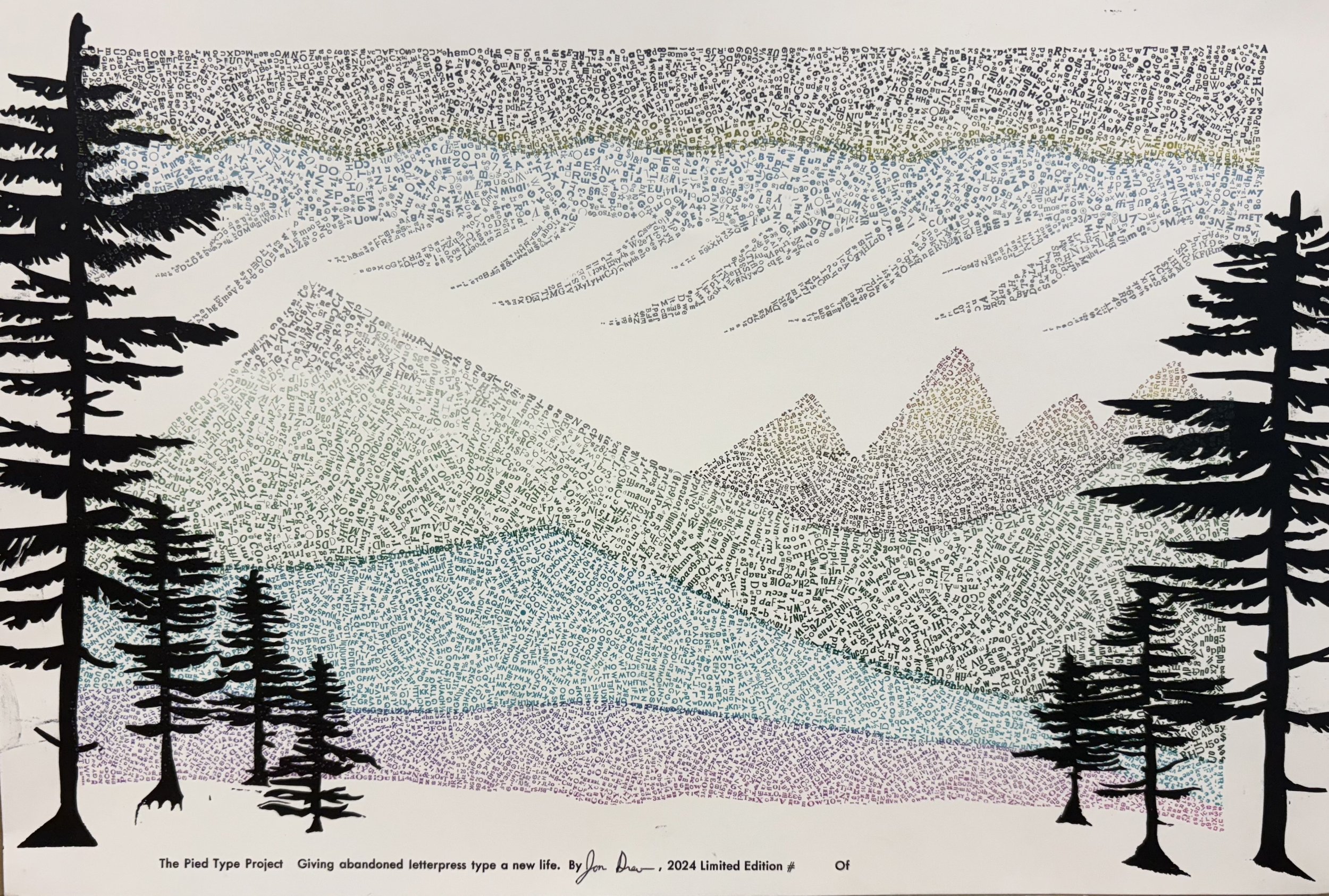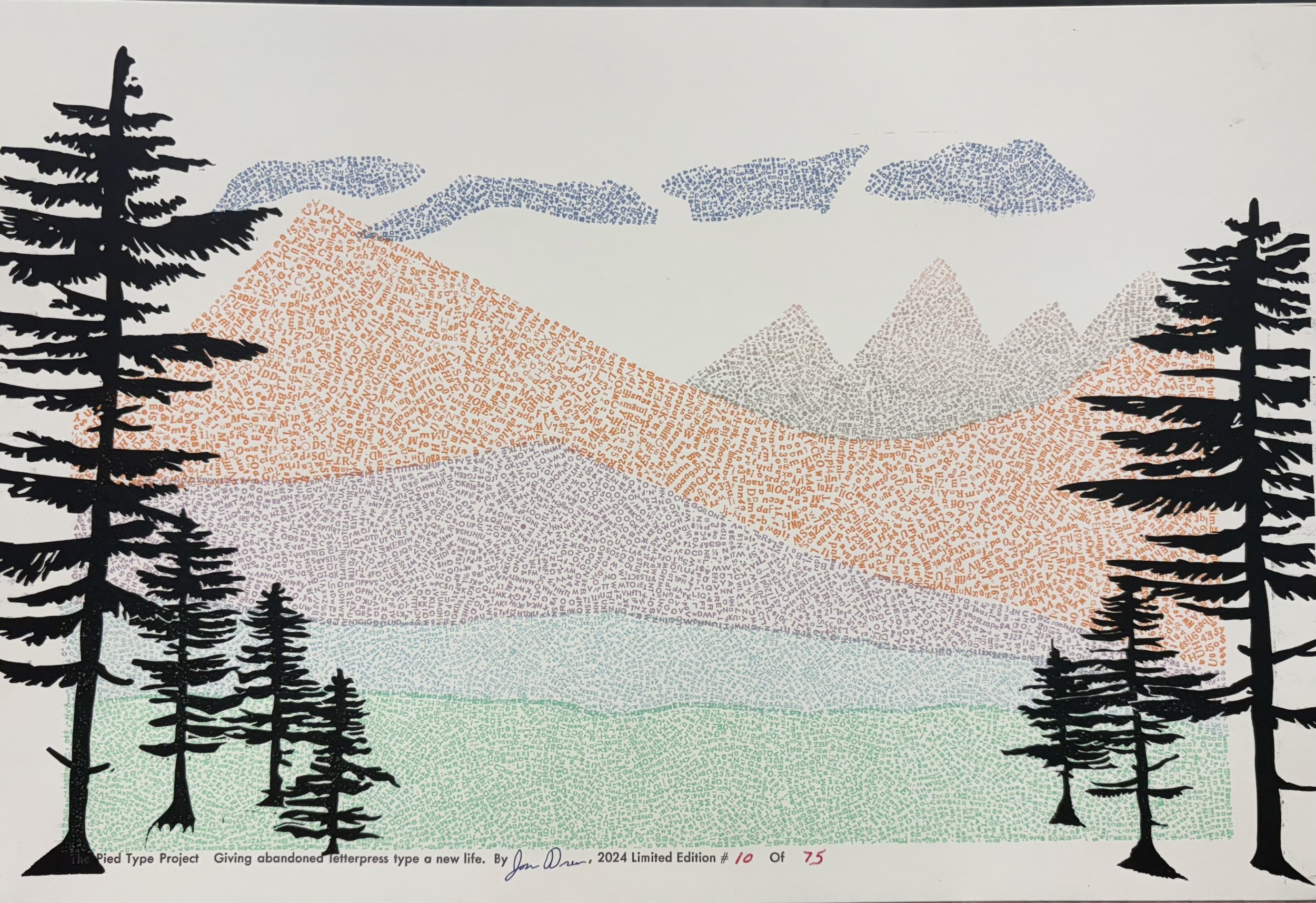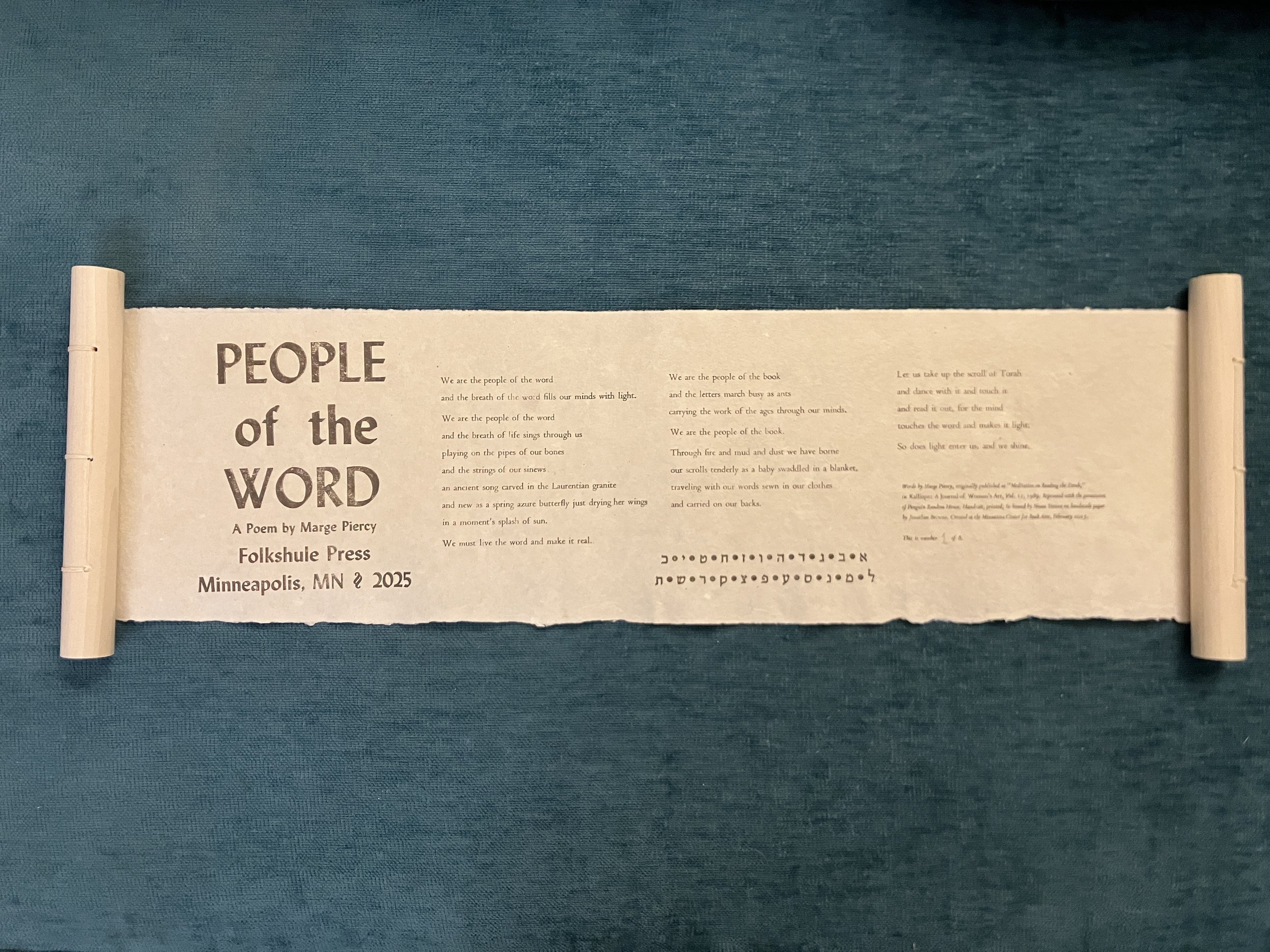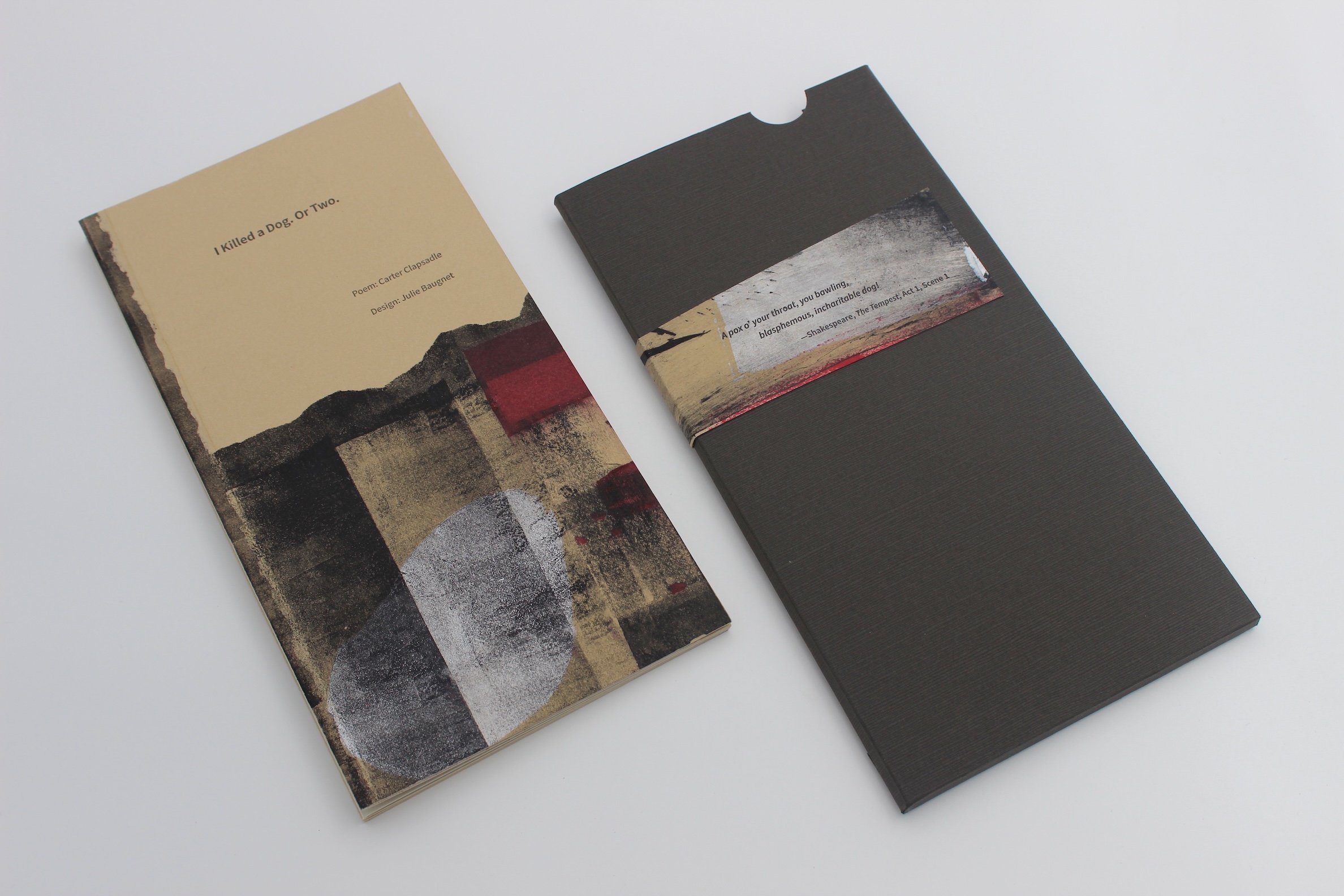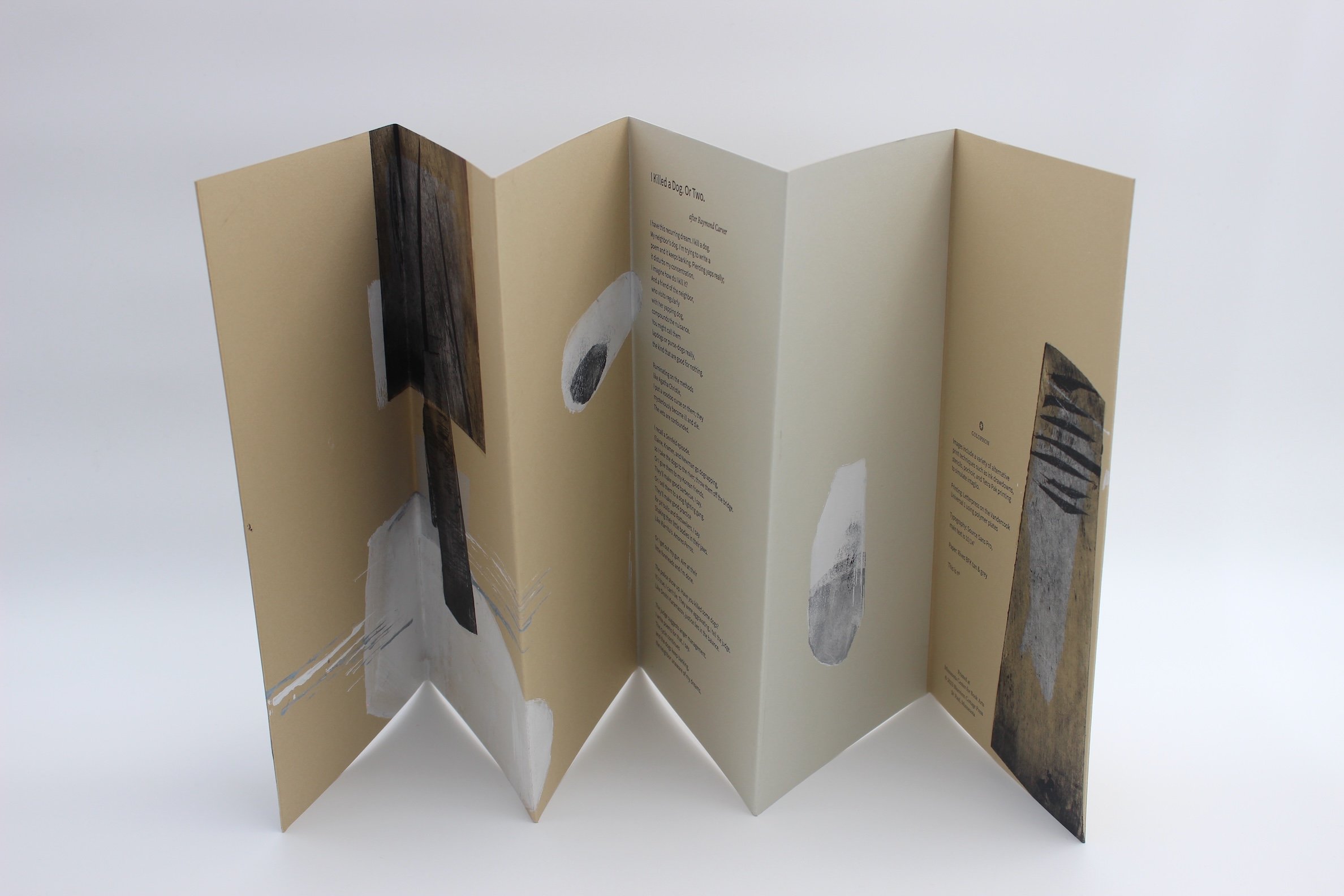
Friedli Gallery’s Fourth Annual Book Arts Exhibition
Available Works
Barrie Mason
Loving Kindness
5 x 55 x 3 in.
$310 (SOLD)
Accordion fold book, handmade paper, thread and printing.
As a written practice this started during Covid and continues to today. For so many they feel like they are just hanging on by a thread.
The through-line for much of my life and work is improving communication, especially communication that facilitates intercultural respect and knowledge. First as an actress, then an academic, and now as an artist the power of communication to enlighten, empower, and engage has been central. These days it is through paper, bookbinding, weaving and felt that I'm working to enlist others in this dialogue. The very immediate nature of fibers makes it a powerful medium and since textiles and paper are the foundation for so many cultural and personal narratives, what could be better.
Barrie Mason is an artist working in a variety of fiber related mediums including handmade paper, marbling, bookbinding, weaving and wet felt. She has exhibited in various venues in Missouri, Illinois, Minnesota, Kansas, and Texas to include the Nelson Atkins Museum in Kansas City, Surface Design's juried Member Exhibition at the Museum of Texas Tech, Banfill-Locke Center for the Arts in Fridley MN, Kansas City Museum, Albrecht Kemper Museum in St. Joseph Missouri, Kavanagh Gallery of the Fine Line Art Center in St. Charles Illinois, and the Bunker Center for the Arts in Kansas City. Barrie teaches book making classes and is the organizer of a local bookmaking group (KC Bookies) which has grown to over 40 members.
Ben DiNino
This Side Toward Screen
7 ¾ x 7 ¾ x 5 ¼ in.
$4,000
MIxed Media Book & Box Set
Hand constructed imitation slide box, hand bound book featuring slide images. 10 imitation enlarged slides in hand silk screened slide moments, LED light screen and cord.
This piece is a limited edition book and box set I created to highlight my collages made from slide and negative film. The book features over 130 of these works from the last 5 years. I hand cut and assembled every element of the book using a tortoise-shell binding. Each set includes 10 random enlarged replica slides of the original work. These imitation slides are printed on PET transparency film, not slide film. I hand cut and silk screened all the slide mounts copying vintage designs from my collection. I’ve included an LED screen to more easily view the slides. I also designed and assembled the entire box to mimic a 1970s slide container. This piece was made as an edition of 10. Besides being a document of these specific celluloid based collage works, I also hope that the entire design pays homage to the look of vintage photographic material.
There are 3 types of collages featured in the work. “Slide Overlays” are pieces created by sandwiching two slides in a slide mount creating a new visual narrative.
In my work I strive to shed light on the overlooked or discarded; those items or places that are forgotten or slightly out of focus in the background. By highlighting their existence or reconfiguring them into something unique I hope to breathe new life into these neglected images and objects. The majority of my artistic practice recently has centered on collage, book art, and assemblage. I endeavor to prolong the life of these outdated how-to manuals, old magazines, snap shots, slide film, and any other materials I‘m able to cut up and reassemble. This is also a challenge since I force myself to create something visually interesting or confusing out of what can at times be banal source material. This is what truly excites me when I work. Sitting down with old liquor advertisements or an outdated interior design magazine and experimenting with the images in an attempt to push the limitations of the source material I’m using.
With my collage work I tend to produce series, developing a collection of works that either come from similar source imagery, focus on a particular theme, or are limited by a number of self-imposed restrictions. I enjoy pushing the assumptions of what the medium of collage is with an attempt to create a more painterly or fine art look from just hand cut paper and archival adhesives. In some of these pieces it is important to know the source material, such as my abstracted collages made out of the backgrounds from mail order catalogs after the models and items for sale have been removed. I hope that my work can be viewed both aesthetically and conceptually.
I view my carved book pieces as found sculptures that I just assist in revealing by excavating the excess text leaving only selected imagery where it was originally printed. The books I choose tend to be old manuals, reference books, and guides which are now destined for the landfill in our digital age. Although their advice and instructions might be antiquated their illustrations can still be appreciated aesthetically. I seal the textblock closed so that only the cover opens which makes it easy to display the work and to store it on a shelf with the rest of a readable library. I enjoy retaining the utilitarian nature of these books, highlighting their continued physical existence as a book and not just a visual work on a wall.
Ben graduated from Tyler School of Art in 1996 with a BFA in Sculpture and a minor in Art History. At the time he was extremely jaded about the art world and didn’t pursue showing his work professionally. Over the next 20 years he continued to make art, trading with other artists, donating work for fundraisers, and generally giving it away. After attending the first Kolaj Fest in New Orleans in 2018 he decided to again become serious about his art practice. Since that time he has been in over 90 exhibitions internationally, has had work featured in a number of print and online publications, has posted a new work everyday on Instagram, and was awarded a public art grant by the city of Minneapolis. He lives in South Minneapolis with his partner and their two children.
Todd Thyberg
Pathogenesis
$850 (SOLD)
3D printing, acrylic, oil, letterpress.
Unusual bound book that is composed of 42 small hexagonal pages. The binding is a cast resin virus that contains the book.
As a book artist, my passion is designing ergodic books that require the reader to participate in the story. My artistic vision is to facilitate deeper emotional connections to my books and promote curiosity by creating works that excite the reader’s senses. The analog nature of exploring a book is frequently lost given our mass consumption of digital media, and I believe that people long to experience something unique and engaging. Through these interactions, my readers connect with the book as an embodiment of craft, an artistic object, and form more sustained memories through exploration.
Todd Thyberg is the owner of Angel Bomb, a Minneapolis-based letterpress studio. He is fulfilling his lifelong dream of creating fine art books and recently finished his tenth book. This work is printed on vintage letterpress presses that Todd has purchased and restored to working order. In 2011 Thyberg received an MCBA/Jerome Foundation Book Arts Fellowship to create The Airship, a letterpress graphic novel and his first self-published book. In 2013 he received an Artist Initiative grant from the MN State Arts Board to create American Manifesto, an activist book inspired by Thomas Paine’s Common Sense. This book then went on to win an AIGA design award. Todd’s third book was a retelling of Frankenstein, celebrating the 200th anniversary of Mary Shelley’s masterpiece. This book was printed in miniature along with a leather looking box which was designed to vend from a restored vintage cigarette machine. Thyberg has taught letterpress at the MN Center for Book Arts (MCBA) as well as private tutoring at the Jamestown Arts Center. Todd’s most recent accomplishment was receiving a 2023 McKnight Book Arts Fellowship. His most recent works include Too Much, a portfolio book based upon his experience sailing in the Arctic Circle and Pathogenesis, an examination of gun violence in America as viewed through the lens of disease.
Jon Drew
PIED Type Project
13.5 x 20 in.
$150 each (SOLD)
Is type alive? Can it speak? Does type have a soul??
I handset a lot of letterpress metal type. Every so often a letter will slip through my fingers and disappear on the floor.
Not wanting to break my rhythm I’ll stay in my chair and continue to set more type.
But INEVITABLY I will start to hear that one little sort call out to me, “Help me” Why would you leave me” “I need to be with my family”.
These cries would become louder and more frequent until finally I would set down my stick, get out of my chair and crawl around on the dirty shop floor and find that one little wayward soul and set it back in line with its family.
Every time I did this I would hear that little letter thank me and would always feel better about myself.
In 5th grade I found a single, new piece of 10 point letterpress type on the sidewalk outside a high school shop class.
A shiny little piece of metal with a letter on one end. It was love at first sight.
In 7th grade I had to take the mandatory Graphic Arts class and found the purpose of that type and my life.
I attended the University of Wisconsin Stout and spent my life as an offset pressman and print shop owner.
In 2007 I started collecting, refurbishing and selling vintage letterpress equipment and type.
I also started working with and mentoring younger letterpress artists.
About 2920 I started the creative process that became the Pied Type Project saving small types from the Hell box.
Bringing full circle to that day in 5th grade, giving that little lost, orphaned and wayward sort a family, home & voice.
Cynthia Gipple
Open Book
22 x 24 x 8 in.
$350
Rives BFK, wire, linen, plastic bags, offcut marbled paper
Plastic bags, Rives BFK paper, linen thread, book board, off cut marbled paper, typewriter type, wire, 26"x20"x6", 5 lbs.
Knee/ hand spun plastic bag cording was knit to form the book covers and pages of this project. Off-cut papers represent fraying thoughts of a memory care resident. I sewed a page with end of life observations into the book. I am the handler of a dog therapy team in the hospice setting, and was intimately involved with the end of life of my parents.
I’m a book artist who draws, writes and prints, makes one-of-a-kind container projects, uses discarded materials, and found objects, inspired by woods and waterways, uses traditional hand techniques like sewing and knitting, and makes How-to Zines.
Wendy Withrow
Embody / In Body
8.5 x 3.5 x 1.5 in.
$400
5 pages made with Heavyweight Lokta Handmade paper. Cover made with Hook Pottery 20 Mile Paper.Sling fold book with paper wrapper cover. Paper, board, Listerine breath mints, dog squeaker, handmade clacker, handmade scratch ‘n sniff paper (embossing power and jello), velvet, sandpaper, origami paper, linoleum, photographs.
2025, edition of 3.
The idea for Embody / In Body came from my experience of parenting children about to enter their teens on the tail end of the pandemic. The tween and teen years are about growing independently, navigating relationships outside of one’s family, and learning how to engage in the social sphere. And yet these kids came of age in a time of online learning, virtual friendship, and heightened awareness of illness and germs. While we might be through the Covid pandemic, we are facing another epidemic of loneliness and anxiety.
In the world we live in it is so easy to get caught up in a world outside of our bodies. Social media feeds, video games, messaging apps, the unending news cycle, podcasts. All give us a kind of connection, but one generally outside of our bodies. In this landscape, we are often unpracticed at and even fearful of being rooted in our physical bodies.
My family regularly uses a grounding technique known as The 54321 Method. Most commonly used as a way to quell anxiety during a panic attack, it asks you to notice five things you can see, four things you can feel, three things you can smell, two things you can hear, and one thing you can taste.
Embody / In Body takes this idea and grows it. What if rather than using it only when acutely needed, it became a ritual, practiced daily? What if through this practice we were able to build body awareness and muscle memory? What if this awareness made it easier for us to access a sense of grounding when anxiety arises? Living in a time of fear and uncertainty, we need rituals to ground us and remind us daily to become rooted in our bodies. Embodiment is a right to which every human has access at all times. And it is through embodiment that we connect to our humanity.
Wendy Withrow creates art in order to process the experiences of daily life as a parent, partner, friend, neighbor, citizen, and steward. She wants people to relate her work to their own lives, recognize familiar emotions and experiences, and tap into a universal sense of the human experience. Various themes continue to arise in her work, including connection and disconnection, body language, spatial relationships, and time and impermanence.
Wendy is influenced by contemporary dance as well as origami and the ceramic arts. Artist Books are particularly interesting for their ability to offer a vehicle for words, texture, shapes, lines, and movement in time. An artist book can tackle global issues while offering an intimate, quiet experience. Ultimately, she seeks these quiet, personal moments with the viewer.
Wendy earned a diploma in traditional bookbinding from the North Bennet Street School in Boston, Massachusetts. Before pursuing the book arts, Withrow studied sculptural ceramics, graduating with a BFA in ceramic art from Grand Valley State University. In addition to exhibiting her artist book work locally and nationally, she makes functional ceramics out of a shared studio with her neighbor under the name Calkins Clayworks.
David Rollins
Viridi Solis
17 x 11 x 4 in.
$450
Color paper and wood. 2025
The works I create convey my interests in transformation through the interaction of art, alchemy, and magic. Medieval alchemists sought perfection and enlightenment in everything, visualizing a hierarchy that resided within all matter. The lowest tier of this scale represented the base, unchanged physical material while the highest tier displayed a spiritual purity and maturity representative of the divine.
Magical practice is also built on a desire to reshape the world. By manipulating elemental, personal, and cosmic energies, magicians could manifest change by the expression of willpower. Likewise, alchemists believed that spiritual elevation toward the divine would naturally reshape a thing’s physical characteristics, creating something new. By reworking material alchemists found that this act could also transmute themselves, moving incrementally toward self-perfection. Transformation, both inwardly and outwardly, of the material world and self were considered the keys needed to unlock the secrets of the universe.
Inspired by these ideas, I work to replicate what alchemists and magicians performed. Through creating drawings and sculpture I reshape the energy within myself, changing and elevating my being and moving toward self-betterment. The resulting artwork becomes a physical manifestation of my personal journey of self-discovery and enlightenment.
Dave Rollins is a book maker, sculptor, Alchemist, and self-proclaimed Wizard. He received his MFA in Book Arts from the University of Iowa Center for the Book (UICB) and his BFA in Sculpture from Middle Tennessee State University (MTSU). He has taught courses in Book Arts, 2D and 3D Design, Drawing I, Drawing II, Art Appreciation, and Introduction to Art at the UICB, MTSU, and Motlow State Community College (MSCC). His books, book sculptures, and drawings have been shown nationally, and he has had several solo exhibitions. At present, Dave resides in Seattle, Washington where he teaches art online and continues to make art while pondering the great mysteries of the universe.
Mads Golitz
Cut and Remove
9 x 6 x 1.5 in.
$128
Cyanotype and relief printed 8-page book. Edition of 7.
My apartment lease states it is my responsibility to “cut and remove all tall grass and weeds over 6 inches in height.” During my first spring, I was faced with how to apply that open ended, yet legally binding, statement to a yard of new growth that I knew nothing about. It felt wrong to hack at any greenery that didn't immediately serve a conventionally aesthetic purpose. So I spent the summer learning about each plant emerging in the yard, which grew into this project.
In my research I found myself looking at each plant’s origin, as well as their impact on our current environment. This led me to discover a collection of botanic neighbors ranging from native to invasive, with a handful of benign non-native species. The irony was not lost on me as I removed invasive species that likely traveled the same boats my ancestors did, neither of us descending from the land we both currently reside on. But unlike a plant programmed for growth, I can choose to reduce my harm and work toward making a positive impact on the community I have found myself rooted in.
Mads Golitz (they/them) is a printmaker and educator living in the midwest. They hold a BA in Studio Arts from the University of Puget Sound in Tacoma, WA. Mads is currently the Education Programs Assistant at Highpoint Center for Printmaking. They have taught several youth and adult workshops of various printmaking techniques. They encourage exploration and experimentation in their students' work as well as their own. Their practice is currently focused on symbolic imagery using intaglio and monotype techniques.
Alex Stoner
Script Flow Free
5.5 x 5.5 in.
$25
Block printed artist book with belly band.
Searching for the story beneath the project, Alex observes the underlying narratives of past experiences to compose his work. By picking up the scattered pieces of a composition, and weaving them together into a continuous story, they bring touching emotion to their art. Recently, they have been exploring ideas regarding patterns, as well as writing and bookmaking.
Alex Stoner is a junior at the Minneapolis College of Art and Design. They primarily focus on printmaking, photography, film, and mixed media; and have an interest in whatever else they get the opportunity to try.
Noam Sienna
People of the Word
9 x 2 x 28 in.
$650 (SOLD)
Paper, wood.
People of the Word is an artist's book in the form of a scroll, printed with handset type on handmade paper, and covered with a paper wrapper (not yet completed, but to be finished in time to deliver to the gallery). It is 9" high and 2" wide when rolled, 28" when unrolled. It weighs 7 oz. It was produced in an edition of eight, and I plan to submit two copies so that it can be displayed both rolled and unrolled. Four copies are available for sale.
Materials: handmade paper, pine wood, waxed linen thread, linen twill ribbon.
The Torah scroll might be considered not just a book, but an ancient ritual technology. In the liturgical life of Jewish communities around the world, the Torah scroll embodies the encounter with Divine wisdom and ancestral connection. Its power is captured by Marge Piercy's poem presented here, which describes how the Jewish people "have borne our scrolls tenderly as a baby swaddled in a blanket," and invites us to "take up the scroll of Torah," opening ourselves to its light. This artist's book was printed manually with handset type, on handmade paper by my uncle Jonathan Browns (1961-2023). In paying homage to the "people of the word," it draws a physical portrait of how wisdom is transmitted and transformed as it journeys with people across time.
Dr. Noam Sienna is an artist and academic scholar whose work explores the intersections of diverse languages, alphabets, and texts across the wide span of history. With particular interests in Jewish-Muslim relations, vernacular translation, and LGBTQ identity, he aims to harness the power of books in connecting people across time and space in a contemporary context. His art draws on traditional forms of Jewish textual art including calligraphy, illumination, and letterpress printing; under the imprint of Folkshule Press, he uses the crafts of hand-typesetting and manual presswork to bring together historical and present-day expressions of Jewish visual and textual culture.
Nicole Soley
NOAH'S ARK (GUNBOAT)
4 x 2 ft.
$800
Etched linoleum, mixed media. An interactive Sunday School game.
Not a Solution to Gun Violence
$300
Etched linoleum, letterpress printed. A postcard printing to the house of representatives.
My work deals with the real and political, taking reality and applying it to political mailings and interactive games.
Soley utilizes contemporary and traditional printmaking processes to create dynamic, multi-process prints. By creating cut out, printed, paper objects, she synthesizes lived experience and research. Through layering many forms of printmaking and experimenting with paper colors, inks, and three-dimensional formats, viewers interact directly with the artwork, interpreting both personal narrative as well as cultural critiques. Her artwork emboldens the viewer to explore printmaking as a liberating story-telling medium; through the expression of personal narrative in a book arts format, we reach closer toward universal liberation.
Nicole Soley is a printmaker and book artist currently residing in the Lakes Region of New Hampshire. Since receiving her Bachelors of Science from Minnesota State University, Mankato with a concentration in printmaking in 2017, she has begun her career as an emerging artist with strong roots in the Twin Cities of Minnesota. Soley has maintained an active studio practice starting with several years at Highpoint Center for Printmaking (2017 - 2023) and has embraced her identity as a printmaker and book artist through back to back Jerome residencies at the Minnesota Center for Book Arts in Minneapolis (2021 - 2022) and Highpoint Center for Printmaking (2022 - 2023). Upon relocating to New England, she embarked on several national and international residencies, returning to the NH woods where she founded Siren Landline Press: a letterpress shop of her own.
Julie Baugnet
I Killed a Dog or Two
5.5 x 10.5 in.
$475
Letterpress and alternative press techniques.
Housed in a Japanese linen paper envelope, this book measures 5.5" x 11". The binding is a laperello, also referred to as an accordion book. The six panels are printed on Rives BFK buff, and grey. Images include a variety of alternative print techniques such as ink drawdowns, stencils, pochoir, and Tetra Pak printing to simulate intaglio.
In my books I explore the common territories of poetry and image. Using color, texture, and the written word, I weave landscape and voice. I create small edition books using paint, mixed media, letterpress, handwriting, and screen print techniques.
I collaborate with poets, both national and international. My latest books are a collaboration with my partner, Carter Clapsadle. As creatives, we work together on ideation, process & planning.
Julie Baugnet received her Master of Fine Arts Degree from the Minneapolis College of Art and Design. She has exhibited widely, both nationally and internationally. Her artists' books are placed in numerous private and public collections, including the Special Collections at The Library of Congress, Emory University, University of California, Berkeley, Vanderbilt University, among others. The excellence of Baugnet’s work has been acknowledged through a variety of residencies, grants, and awards, including a fellowship from the Atlanta Center for the Arts and a Jerome /Mn Center for Book Arts Fellowship. She has a print and binding studio in Wisconsin.
Mel Benkert
Imprints
170 x 80 x 70 mm.
$495
Used library cards, handmade paper, mark-making media, ink, bamboo, magnets, recycled washers, waxed linen thread, micro paracord, acid-free adhesive
I pursue stillness in a world that rarely pauses.
I am a book artist working at the intersection of sculpture and visual narrative. Using traditional forms and unconventional materials, I examine the imprints left behind - marks of experience, circumstance, and change. Each impression shapes a record of place and time.
Collaborating with the work of fellow creatives, the visual elements of my work are integral to the narrative, and in the absence of text, they stand out. My work responds to both personal loss and broader, global shifts—where knowledge is contested, people are abandoned, biodiversity is disappearing, and what remains is often what is fought for. In this uncertainty, my work presents to archive - document, question, and preserve our evidence.
Mel Benkert (she/they) is a book artist based in St. Paul, MN. Originally from rural Michigan, they have a background in metal and woodwork, teaching, and technology. They are interested in the way books can become sculptural objects that interact with the space around them. Like a cartographer mapping terrain, Mel’s work explores how “place” is defined and how time shapes our understanding of it.
Mel studied fine art at the College of Visual Arts in St. Paul and has exhibited in local galleries since 2003. Their work is held in the special collections of Hennepin County Library and the University of California Irvine, as well as in private collections. They have taught at the Eagan Art House for over 20 years and were a 2023 Studio Fellow at the Minnesota Center for Book Arts (MCBA).
Louise Fisher
How to Change Day to Dusk
10 x .25 x 8 in.
$349.99
Perfect bound artist book. 15 copies available
Cloud House: Bungalow
5.5 x 6 x 3.5 in.
$254.90
Inkjet, paper sculpture
I am an interdisciplinary artist working in the expanded field of printmaking; using methods of layering, sequence, and repetition for its metaphorical enactment of time and memory. My current work explores how the built environment affects humans as well as its broader impact on the ecosystem. I’m largely driven by the physical and emotional responses I have to my surroundings. This reflects a larger field of study called “environmental psychology”, which examines interactions between people and their physical environments, as well as its effects on human behavior and health by analyzing visual cues such as layout, color, texture and lighting. Place especially has a profound effect on my artwork. I grew up in the rural Midwest, where I had access to expansive skies and tallgrass prairies that both inspired and calmed me. This is my inner landscape, and I take it with me wherever I go–giving me a heightened awareness of the external environment.
In my work, the visual barriers to the sky, such as grids and windows, capture the feeling scholars have coined “species loneliness”–the alienation humans feel from the landscape and nature at large. My process begins by photographing skies and architectural elements in my immediate surroundings, which sometimes become drawings, digital prints, or vectors for laser cutting. In my work, I combine these images to point out commonly overlooked juxtapositions in the landscape–such as hard-edged windows and soft clouds. By integrating visual opposites such as geometric and organic forms, and digital and hand-drawn imagery, I point to our mediated experience of nature and a longing for the more-than-human world. In seeing my artwork, I help others reconsider their relationship to the land.
How to Change Day to Dusk is an artist book that conveys the cognitive and emotional experience of shopping for my first home in the post-pandemic housing market, specifically via Zillow. The houses you see are appropriated and curated from the app and all feature ubiquitous cut-and-paste Photoshop edits. Real estate photographers add artificial light to the sky, windows and light fixtures to an otherwise day-time photograph in order to romanticize the property. In this piece, I explore what it means to long for the American dream of a single-family home while it is unattainable for so many. This book is inspired by countless hours scrolling Zillow and reading housing market news articles, Ed Ruscha’s early artist books and 20th century home builders catalogues.
Louise Fisher is an Minnesota-based visual artist residing in the Twin Cities, where she teaches drawing and printmaking courses in the Art Department at Normandale Community College. Louise has exhibited both nationally and internationally, and artwork is included in public collections such as the Wichita Art Museum Permanent Collection, the James K. Hosmer Special Collections at the Hennepin County Library and the Zine Web Archive at the Library of Congress. Her most recent accomplishments include receiving the 2023-2024 Jerome Fellowship at Minnesota Center for Book Arts and the 2021 Jordan Holly Fellowship Award as an artist-in-residence at In Cahoots. In her work, Louise explores themes of the natural and built environment through prints, artist books and installations.








